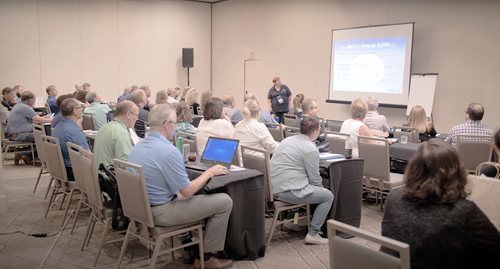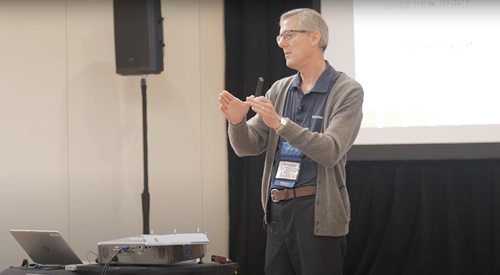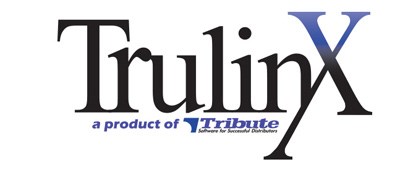Rehearsal Tips for Presentations
Share
Do you have a presentation coming up that you’re feeling nervous about? Trust me, we know the feeling. The staff members at Tribute Inc. provide instructional presentations every year at TribNet, our annual user’s group conference. Our team runs multiple trainings on our industrial ERP software solutions, Tribute and TrulinX, discussing recently implemented platform features and reviewing upcoming development projects. Our traditional in-person conference typically draws in about 150 customer attendees, and our virtual conferences the past two years has brought in up to 500 attendees!
Having to speak in front of that many people can certainly be an intimidating task, even for someone who has experience presenting to large groups. We’ve been hosting our annual TribNet conference for over 35 years and yet we still get butterflies. We always make sure that we’re prepared because it’s very important that we create an engaging presentation and provide a good learning experience for our users.

Below are some helpful presentation tips we use when preparing for a big meeting or conference. These can help you memorize your material, calm your nerves, and prepare for a successful presentation.
Tips for Effective Presentation Skills
A common reason for anxiety is the fear that we will forget something important that we wanted to say. Many people combat this fear by creating detailed PowerPoint slides as a memory aid. But this can actually signal to the audience that you are too reliant on your slides and not credible. Try some of these memory tips instead, as suggested in this article by Bruna Martinuzzi for the OPEN Forum:
Use the Palace Method
Humans remember things on the basis of spatial locations. To use the Palace Method (also called "method of loci"), To create a memory palace, think of your home, a familiar street, or some other memorable place. Mentally walk around your home, street, etc. and number stops along the way. On each stop, you place a piece of information that you want to recall.
Use Mind Maps
Mind maps are diagrams that allow you to lay out all of your presentation material in a visual shape rather than in list form. Try practicing your presentation from a mind map instead of traditional notes and see what happens.
Practice the 20-20-20 Rule of Rehearsal
How long should you be rehearsing your presentation? Memory experts recommend the 20-20-20 rule which prescribes going over the details of a presentation for 20 minutes, then repeating the same material twice more.
Know the Value of Focusing for Eight Seconds
Memory experts tell us that it takes an uninterrupted eight seconds for a piece of information to be processed into memory. Carve out dedicated time when you can be laser-focused on rehearing the information without any interruptions.
Rehearse Out Loud
This tip may seem obvious, but there are many people who tend not to do it. Rehearsing out loud might feel awkward at first, but it’ll help give you confidence and get a feel for your presentation. Try rehearsing your entire presentation out loud at least five or six times.
Record Your Presentation
A simple (yet surprisingly not widely known) feature in PowerPoint is the record narration function. This allows you to record yourself delivering your presentation and then playing it back. Hearing yourself narrating your presentation will provide you both a visual and auditory memory aid.
Practice Your Presentation to Music
Consider listening to music (such as classical music with approximately 60 beats per minute) while rehearsing your presentation to help you absorb and retain large amounts of information.
Rehearse Before Bedtime
Neuroscientists have found that sleep enhances the consolidation of recently acquired information in our memory system. Therefore, if you rehearse your presentation just before bedtime, you are more likely to remember the material more easily in the morning.
Here are some additional tips on preparing for a presentation via SketchBubble:
- Practice, practice, practice
- Don't read from your slides or notecards
- Know what you're talking about
How to Calm Nerves Before a Presentation
Do you get extra nervous when speaking in public? Try these pointers to manage presentation nerves, courtesy of Mind Tools.
Know Your Audience
The more confident you are that you are presenting your audience with useful and interesting material, the less nervous you will be overall. Before the presentation, make sure that you:
- Define who your target audience is.
- Ask people who are representative of the audience what they expect from the presentation.
- Run your agenda by a few people to see if they think something is missing or is overkill.
- Greet audience members at the door and do a quick survey of why they are there and what they expect.
Know Your Material
You don't have to be an expert, but you'd better know your material very well on presentation day. Consider selecting the most pertinent points from your subject base and then supplement with other material if time allows.
Structure Your Presentation
Try these techniques to give yourself clues to what is coming next:
- Have a set of key phrases listed on a cue card.
- Refer to these phrases to trigger your mind as to what is coming up next.
- If you're using slides, use these key phrases in your transitions.
Prepare, Prepare, Prepare
Once you know what you are going to say, you need to prepare yourself for the actual delivery.

- Decide what you are going to wear – make it comfortable and appropriate.
- Arrive early and get your equipment set up.
- Anticipate problems and have backups and contingencies in place in case something doesn't work, you forget something, etc.
- If possible, give everything one last run through in the real environment.
- Prepare responses to anticipated questions. Try to think like that one person in the front row who always tries to trip the presenter up.
Calm Yourself from the Inside
Counteract the physiological effects of nervousness with these techniques:
- Practice deep breathing
- Drink water
- Smile
- Use positive visualization techniques
- Press and massage your forehead to energize the front of the brain and speech center
- Just before you start talking, pause, make eye contact, and smile
- Speak more slowly than you would in a conversation, and leave longer pauses between sentences
- Move around during your presentation to expend some nervous energy
- Remember STAY (Stop Thinking About Yourself). Remember that the audience is there to get some information and it is your job to convey it.
Additional Rehearsal Tips from The Experts at Tribute
Julie Irvin, Tribute’s Training & Development Manager, provides some additional tips that are put into practice by our team members when preparing for our annual conference.
- Before gathering your content, understand first the “why” of your presentation. At a high level, you first want to understand what you are working to achieve, and what outcome you want the audience to have. For example, one of our objectives at the TribNet conference is to build and strengthen relationships with our customers and help them get the most out of our product. You can expand on the “why” depending on the subject matter you are teaching, and get more granular.
- From the outset of your presentation, make sure to help the audience understand why they should listen to you. You can do this by, for example, establishing credibility, listing up front what they will learn and what benefits they will receive after attending your presentation. Establishing creditability includes speaking clearly and with confidence, be prepared and organized, and not reading your slides to the audience.
- Build engagement by answering these questions for your audience: What are we doing? Why does it matter to them? How will they do what you are teaching them to do?
- Know your audience. What knowledge level do they have? What is their relationship to you and your organization? Why are they/would they attend your presentation – what do they want to know? We present to a customer base that we have long standing relationships with so we can usually gauge this up front, but you can also ask your audience at the beginning what they came to learn so you can make sure to incorporate that into your talk.
- Use the Rule of Three when presenting highly detailed information. Research shows that humans can retain and understand information when you boil complicated or detailed content into chunks of three.
About Tribute Inc.
 Tribute is a leading provider of ERP distribution management software for industrial distributors that provide value-added and fabrication services. Each year we hold an annual user's group meeting (TribNet) focused on networking, collaboration, customer input and instructional presentations of our software features. If you're interested in TrulinX, an upgraded technology for your distribution business, please contact us today or request a free demo!
Tribute is a leading provider of ERP distribution management software for industrial distributors that provide value-added and fabrication services. Each year we hold an annual user's group meeting (TribNet) focused on networking, collaboration, customer input and instructional presentations of our software features. If you're interested in TrulinX, an upgraded technology for your distribution business, please contact us today or request a free demo!
